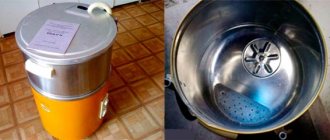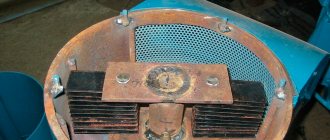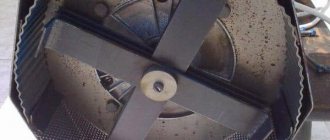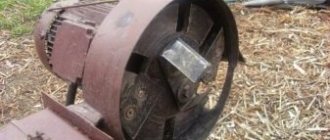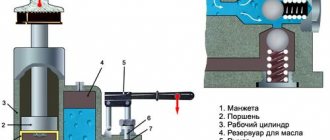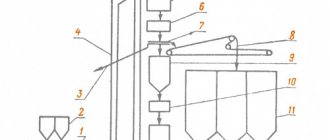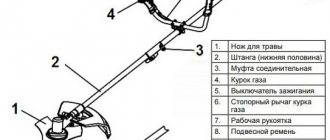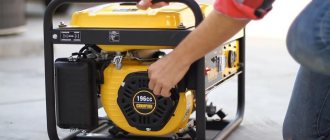Grinder grinder
Grain crusher from a grinder
You can assemble a grain crusher using an angle grinder (grinder) with a disc size (diameter) of 115 or 125 mm as an engine.
The assembly process of such a device consists of the following steps:
- A rectangular or round base is cut out of waterproof plywood 8-10 mm thick with a jigsaw.
- A round hole is made in the center of the base for the grinder gearbox.
- Diagonally from the central hole on the base, another hole is made for the grain bin.
- The chopper knife is made from hard high-carbon steel 1.5-2.0 millimeters thick.
- If necessary, the knife is released over the fire and a hole is drilled in the center for mounting on the gearbox shaft of the grinder.
- Using sandpaper, the knife is sharpened.
- The grinder is placed on the base, its round protrusion is placed in a pre-cut hole.
- Using a homemade clamp made of metal tape and two screws, the angle grinder is secured to the base.
- A sharpened chopper knife is attached and fixed to the grinder shaft.
- The old pan is cut in half, holes are made in its bottom with a 4 or 5 mm drill;
- The resulting sieve is secured to the base on the knife side using 4 corners, rivets or screws.
- The assembled grain crusher is placed on a capacious container - a bucket or large metal pan. A plastic 5-liter bottle with a cut bottom is inserted into the hole for the grain bin.
During operation, the grinder is connected to the network, and the constant speed of the knife is set with a locking button on the handle. To obtain flour, grain is poured into a homemade receiving hopper - a plastic bottle.
Be sure to read:
How to make a vegetable cutter for livestock with your own hands from scrap materials.
In this case, to regulate the flow of grain, a movable tin valve is inserted into the neck.
Design features
It’s not just the financial component that forces you to start making grain crushers yourself. Yes, for factory models they sometimes ask for 10-20 thousand rubles or more. Someone is willing to pay that kind of money. Others have them, but they don’t see the point in overpaying when you can assemble everything yourself.
In fact, a grain crusher can be thought of as a coffee grinder enlarged several times. Grains are also loaded there, after which the device starts up and the process of crushing into small fractions begins.
But still there is a difference. And it consists in the following points:
- The coffee grinder turns the beans into powder. The crusher creates fractions of coarser grinding, and their size can be adjusted with a replaceable sieve.
- Devices for crushing grain are capable of processing several tens or hundreds of kilograms of product per hour. A coffee grinder has limited capabilities.
- The equipment has the ability to work for a long time without stopping. Some are capable of crushing for several hours. Others recommend turning it on for a maximum of 1 hour followed by a break.
Structurally, grain crushers have certain components.
The device consists of:
- Protective housing. Assembled from metal, plastic or composite materials.
- Supports. It is installed permanently and in a specific place, or can be removable for carrying equipment.
- Bracket. Its adjustment is carried out using a bolt and nut.
- Second basics. It has a special softener. Looks like a rubber shoe.
- Pairs of motors and pulleys.
- Seals. Necessary to soften vibration during equipment operation.
- Knives. With their help, grain and other products are crushed.
- Funnels. Through it, raw materials are poured into a bunker for subsequent processing.
- Locking mechanism.
- Removable grilles. They are needed to regulate the size of the fractions passed into the container for ready-made raw materials.
- Rubberized wheels.
All these components can be installed at home on a washing machine that is no longer suitable for performing its direct duties.
Grain crushers assembled on the basis of an automatic machine have the highest productivity and capacity.
When selecting or manufacturing components, it is necessary to start from the overall dimensions of the base from which the grain crusher is made. Without balancing, homemade units will not be able to work properly.
Grain crusher from a washing machine
Grain crusher from a washing machine
You can make a simple and productive grain crusher from an old vertical type activator machine (Oka, Volga, Fairy) as follows:
- The squeezing device is removed from the machine.
- With the washing machine on its side, unscrew the fixing (locking) screw or bolt on the activator pulley.
- Having installed the machine in the working position, the activator is removed along with the shaft.
- A plate of galvanized sheet metal of the appropriate size and shape is attached to the activator niche.
- The shaft is unscrewed from the activator.
- A trapezoidal knife is cut out of an old circular saw and rapid blade, the diameter of which is slightly smaller or the same as that of the removed activator.
- The knife is sharpened using sandpaper and secured to the shaft using two nuts.
- The shaft with the attached knife is inserted into the hole in the tank and secured in the pulley with a locking screw.
- To collect the final grinding product - flour - the drain hole at the lowest point of the tank is widened using a hammer and chisel, a piece of steel pipe is inserted into it and brought out at an angle.
- To prevent large particles from getting into the final product, a fine-mesh steel mesh or a sheet of galvanized sheet with holes 4-5 mm in diameter is installed in front of the hole for collecting flour at an angle of 60-700.
- To load grain into the removable lid of the machine, widen the existing hole and insert a 5-liter plastic bottle with a cut bottom into it.
The advantage of such a homemade grain crusher is that its assembly does not require drawing up a drawing or making a base for the engine.
In addition, it has good stability, has a spacious tank (up to 30-40 l) and low electricity consumption.
Grain crusher from a vacuum cleaner
Grain crusher with an engine from a “Raketa” vacuum cleaner
To make a simple and reliable grain crusher, working but unused Soviet vacuum cleaners such as “Raketa” and “Saturn” are used.
Be sure to read:
How to make a cone for slaughtering poultry with your own hands, how much does such equipment cost?
The production of such a grain crusher is carried out as follows:
- The motor in the housing is removed from the vacuum cleaner.
- The chamber with the suction impeller is removed from the motor shaft.
- A round base is cut out of thick sheet steel.
- A hole is cut out in the center of the base for the motor shaft, and a hole is made on the side for the grain bin.
- The motor housing is secured to the base using screws and brackets.
- A trapezoidal pre-sharpened knife is attached to the motor shaft.
- A sieve made from an old saucepan with 4- or 5-mm holes in the bottom is attached under the knife.
For convenient operation of such a unit, it is attached to the container with special clamps and short self-tapping screws.
Important! The hole into which the grain bin is inserted and through which raw materials are supplied for grinding must be located in the rotation zone of the chopper knife. If the rotation zone of the knife does not completely cover the feed hole, not covering 1 centimeter or more, most of the grain will spill out and not be crushed, thereby clogging the sieve.
DIY assembly
There are quite a lot of self-made grain crushers from an angle grinder or an old washing machine. This is a popular solution that has gained trust and demand among household owners.
The designs are inexpensive, but effective and quite productive. To cover the needs for maintaining a couple of heads of livestock and several dozen poultry, there is enough to spare.
Washing machine
The first will be a grain crusher, assembled with your own hands based on an old washing machine and its electric motor.
The result may be an excellent household crusher for different types of grain, assembled with your own hands.
To assemble you will need to perform the following operations:
- Make knives that will carry out crushing. They should be sharpened on a special machine and finished with whetstones or fine-grained sandpaper.
- The knives should be installed so that they intersect with each other. Consider equal indentation in each direction. This will ensure symmetry and optimal balance. As a result, the knives should form a four-pointed star.
- Using clamps or a vice, fix the knives, align them and make a through hole at the intersection point. The diameter is selected so as to ensure rigid fixation on the shaft, which transmits kinetic energy from the electric motor through the pulley. The shaft will be located in the area of the activator, which is built-in.
- Secure the shaft using a wrench or adjustable wrench. Here you cannot do without press washers for reliable fixation of the shaft.
- Install the prepared knives on the shaft of the structure. Fix two cutters one after another on the axis and tighten with clamping nuts. As a result, each knife will occupy its own horizontal plane.
- Go to the washing machine drain hole. Water was leaking through it. Now there will be a funnel there. In order for the raw materials to pour out faster after grinding, it is recommended to lengthen the funnel to 15 cm using a round file and a hammer. Insert a piece of pipe into the already widened hole and set the desired direction. Consider where and how the crusher will be used.
- Make a metal mesh at an angle of 15 degrees. Make sure that the edges do not form gaps, otherwise unprocessed grain will fall through them. When placed correctly, the mesh will allow you to quickly remove debris, leaving only high-quality feed materials. Place a container under the mesh where the ground grain will fall.
- Measure the level of lifting of the cutter legs, above which they cannot rise. Test run the engine at low speed. Make a mark at the height of the walls where the funnel takes the raw materials from. Move 1 centimeter from this mark and draw a line.
- Make markings and then cut the mesh. It should be the same size as the funnel.
- Install the element so that the edges follow the intended line. Apply a layer of sealant around the perimeter. This will prevent the penetration of whole grain through the gaps.
So you get an interesting grain grinder, which you assemble yourself from old washing machines.
Be sure to check the functionality of the device. Load the first batch of grain. See how well and quickly the grinding occurs. If necessary, make adjustments to the design.
If you make such a grain crusher correctly, then at home it will be able to cover all the needs for farming, preparing feed and more.
Bulgarian
Even homemade grain crushers are assembled at home and from ordinary angle grinders or simply grinders.
A distinctive feature of the tool is that the axis here is perpendicular to the cutting disc.
It is not so rare to find homemade household grain crushers made at home from one of these grinders.
To assemble you will need to do the following:
- Measure and cut a rectangle from plywood at least 1 centimeter thick.
- Cut a round hole in the rectangle, starting from the base of the structure where the saw blade rotates.
- Use the included metal bracket and bolts to secure the plywood. The axis should point down.
- Using a steel strip, you should make a cutter of suitable length, width and thickness. The knives are sharpened on a machine and then finished. Make sure the cutters are centered.
- Now you should make a hole near the grinder mounted in the plywood and crushing container and install a funnel. Through it, whole grain will be poured into the crusher. The funnel with the hole should be placed not under the grinder drive, but above it.
- Below you need to secure the sieve. Any old and unnecessary pan will do. Using a small drill, make the required number of holes.
Now you need to assemble the structure. It is installed on a box or pallet. Place a bucket or large basin under the lower funnel, from where the crushed raw materials will be poured.
Meat grinder
Another option that allows you to make a home grain crusher without extra costs with your own hands.
First, make sure that the old meat grinder is still capable of grinding grain. To do this, try manually scrolling a small portion of raw materials on it.
The advantage of this method is that the knives do not need to be remade. There are usually good and durable cutters here, and some meat grinders were equipped with a whole set of interchangeable knives. To achieve a fine fraction, it is enough to use a standard small sieve from the set.
To avoid adding grain in small portions through the feed opening, it is recommended to install a large funnel. To do this, just cut off the bottom of a 20-liter bottle and insert it into the hopper of the meat grinder.
Make a hole in the lid. The diameter should be such that the grain does not pass through the neck of the bottle faster than the device can process the grain.
Crushers made from meat grinders are not particularly suitable for crushing grain that is too hard. The mechanism may fail.
It turns out to be a hand tool. But you can connect a motor to the handle and provide rotation using an electric motor.
Vacuum cleaner
There are other options for making homemade grain crushers. For example, this device is based on an old Soviet vacuum cleaner.
Here it is optimal to use such cleaning assistants as Saturn, Rocket or Uralets. If you have a similar specimen lying around somewhere in your dacha or garage, it can make a good grain crusher.
In this case, you will need to do the following:
- remove the motor from the vacuum cleaner body;
- disconnect the suction path, disconnecting it from the engine axis;
- cut a rounded base using sheet steel with a thickness of at least 2 millimeters;
- focusing on the center, cut a hole in the steel sheet to install the motor shaft;
- next to the first hole, cut another one, which will be used to enter the bunker;
- install the engine on a metal base, securing it with bolts and clamps;
- attach a trapezoidal type knife to the motor shaft, turning it from high-quality steel;
- place a sieve under the cutter, which can be made from an ordinary old pan;
- select the diameter of the holes in the sieve pan individually, based on the desired size of the processed grain fractions;
- using staples and screws, secure the structure to the container where all processed grain will be collected.
Here it is extremely important to eliminate all possible gaps so that the whole grain does not clog anything and the device functions normally.
Instead of the vacuum cleaner itself, you can use a drill, hammer drill, or screwdriver with sufficient speed and power as a drive.
Just keep in mind that the power of screwdrivers is usually not enough to process wheat or other durum grains efficiently and in large quantities.
Types of grain grinding machines
Types of machines for grinding grain
Depending on the grinding method, design and location of the working parts, there are 4 types of grain crushers:
- Rotary – crushing of grain in such devices occurs due to a rotor located horizontally and moving at high speed.
- Hammer crushers - the design of such grain crushers includes a rotating vertical drum and stationary hammers located in a circle, against which the grain is crushed. When grinding in this way, the finished flour is poured down and, passing through a sieve, ends up in a container placed under the deck of the housing.
- Roller crushers crush grain due to 2 rollers located in one chamber, rotating towards each other. At the same time, the gap between them is so small that the incoming raw material is not simply crushed, but, due to high speed, is crushed into dust. The advantage of such devices over others is the ability to crush grain with high humidity.
- Millstones are grain crushers in which grain is crushed when it gets between two discs (millstones) located with a small gap. In this case, one disk rotates at high speed, and the second is stationary.
Be sure to read:
How to make an incubator with your own hands: with automatic and manual turning, types, description
Among these varieties, the most common are rotary and hammer ones - they are more productive, reliable, and easier to repair and maintain.
Structure of a grain crusher
Grain crushers are mainly used for farms, but ordinary summer residents and people who regularly live in villages often resort to using grain crushers. Some of them, wanting to save money on its purchase, managed to use an ordinary washing machine for this purpose with minor modifications.
A grain crusher is a technical unit with which you can make feed for feeding livestock at home. It is made by crushing and grinding various grains to a fine consistency.
Video: Homemade feed crusher
For more details about the grain crusher with your own hands, watch the video:
It is known that the processed and crushed product is much better absorbed in the animal’s body, which has a positive effect on its reproductive functions and productivity, which is expressed in milk production and egg laying.
Thus, we can say that the grain crusher is an indispensable assistant for any farmer who maintains large or medium-sized livestock and poultry.
Frequent purchases of ready-made feed can significantly hit the budget, but making feed yourself will allow you to save quite a lot of money.
This link will tell you how to make a cultivator with your own hands.
The operating principle of all grain crushers is similar to the operation of a conventional household coffee grinder, only on a more global scale. The unit is first plugged into a regular power supply, after which the engine is started. This is very important, because the engine must first warm up before you can start working.
Next, raw materials for processing are poured into a special tank (hopper), after which it enters the crushing chamber, where the grinding process itself takes place. Grinding occurs using special knives located in this chamber.
Then, the raw materials are sifted through a sieve of a certain diameter (usually there are several of them in a set). It is the diameter of this sieve that will determine the fraction, i.e. degree of grinding of grain or other crops.
By the way, depending on the characteristics of a particular grain crusher, it can process a wide variety of raw materials:
- rye;
- barley;
- legumes;
- corn;
- cake;
- husk, etc.
Some units are equipped with a special disc grater that allows you to grind various root vegetables, fruits and herbs.
In general, the design of a grain crusher is quite simple, so it is quite possible to make it at home.
There are quite a few detailed methods with drawings describing this process on the Internet. The method of converting from a washing machine deserves special attention , because its device is already somewhat reminiscent of the notorious coffee grinder.
You will find all the information about the AID-2 milking machine in this article.
Crushers for home use
“Vikhr ZD-350K”
Among factory-made grain crushers, the following models are most suitable for private farms:
- "Whirlwind ZD-350K";
- "Zubr-2";
- "Three Little Pigs 350";
- "Farmer ISE-05";
- "Cyclone-350";
- "Bison 400";
- "NIVA IZ-250".
"Zubr-2"
Important! The average cost of a factory installation, depending on power, performance and brand, ranges from 2000-2300 to 6200 rubles. Assembling a homemade device if you have an unnecessary working washing machine, an old vacuum cleaner, or an angle grinder will cost only 500-1000 rubles.
"NIVA IZ-250"
Grain crusher performance
Productivity is the most important characteristic of grain crushers, which indicates the amount of grain they grind per hour (kg/h).
For homemade and factory models, the average is:
- Homemade units - up to 150-200 kg / h;
- Factory models - from 180 to 400-500 kg / h.
Moreover, in most cases, the productivity of factory crushers cannot be increased, while for any home-made unit this characteristic can be significantly improved by changing the power unit (engine) to a more powerful one.
